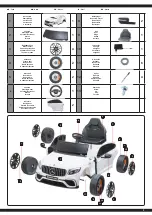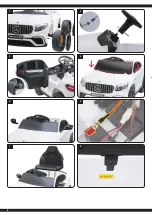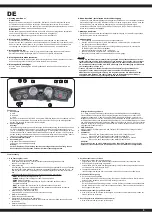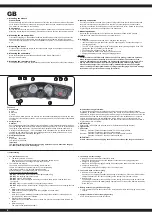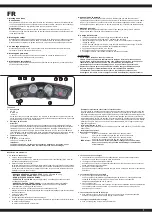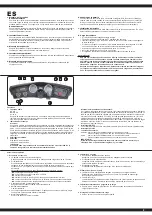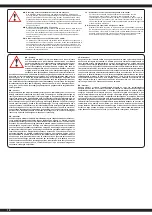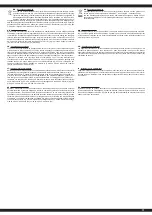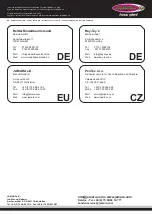
6
GB
1. Mounting the wheels
Front wheels
Start by mounting the front wheels. Slide a washer onto the front axle and fit a wheel. Be careful
not to confuse the front and rear wheels. Inserting a washer from the outside and secured with a
clip. Mount the other wheel in the same way.
Rear wheels
Put the rear wheel on the rear axle. From the outside a washer is put on and secured with a clip.
Mount the other wheel in the same way. Press the wheel covers onto the front and rear wheels.
2. Mounting the steering wheel
First connect the plug on the dashboard cable to the black plug protruding from the front of the
chassis interior. Connect the cable in the steering wheel to the cable in the steering column.
Then slide the steering wheel (4) onto the handlebar and tighten it. The hole position is fixed by
a nut.
3. Mounting the doors
Fit the car doors by aligning them with the recesses and hinges in the bodywork. Then secure
the doors with 2 screws
4. Mounting the windshield
Move the windshield to the intended position. Drücken Sie die Zapfen in die
Nuten, bis sie einrasten.
5. Mounting the rear-view mirrors
Press the rearview mirrors into the intended positions on the car doors until they click into place
6. Battery connection
Connect all connectors as shown. Only connect plug connections that fit into each other and
take care not to reverse polarity. Make sure that the red cable (plus) and the black cable
(minus) are connected to the respective connectors of the same colour. Switch on the vehicle
by pressing the red button on the right side of the dashboard..
7. Mounting the seat
Insert the two pins at the rear end of the seat into the holes provided for this purpose.
Take two of the enclosed screws and fix the seat with them.
8. Charging
•
The power swich must be turned in OFF position when charging.
•
Insert the charger (13) into the socket - the LED lights up green. Connect the charger to
the charging socket.
•
The LED on your charger lights up red as long as the battery is being charged. If the LED
lights green again, the battery is fully charged.
•
The charge time is between 8 and 12 hours.
•
Do not charge the battery more than once within 24 hours.
•
Charger and battery heat up during the charging process.
Warning!
•
Let the model cool off sufficiently after each use before putting it back into operation.
When using an additional batteries let it cool off for minimum 15 minutes until the
model is operated again. Overheating can damage the electronics or may result in fire.
•
Always disconnect the model from the charger immediately after charging. Always
disconnect the charger from the power supply immediately after disconnecting the
model. Inserting the rechargeable model or charger after charging will result in damage
tothe model, charger or the power supply (fire hazard).
Troubleshooting
1. The vehicle does not run
● The battery may low on power.
After each use, or once a month minimum, charge the battery. Do not
leave the battery on the charger for more than 12 hours.
● Thermal fuse has tripped.
The vehicle is equipped with a self-resetting fuse. When the
vehicle is overloaded or operated incorrectly; the self-resetting
fuse will be cut off for 5 - 20 seconds before becoming
operational again. The self-resetting fuse is under the seat
Cut off the power, follow these guidelines:
-
DO NOT
overload the vehicle, Maximum weight allowed: 25 kg
-
DO NOT
tow anything behind the vehicle.
-
DO NOT
drive up steep slopes.
-
DO NOT
drive into fixed objects, which may cause the wheels to spin, causing the motor
to overheat.
-
DO NOT
drive in very hot weather, components may overheat.
-
DO NOT
tamper with the electric system, Doing so may create a short circuit, causing the fuse
to trip.
● Battery connector or wires are loose.
Make Sure the battery connectors are firmly plugged in to each other.
● Battery is dead.
Have you properly maintained the battery according to the directions? Is the battery old?
Your battery may need to be replaced.
● Electric system is damaged.
Water may have corroded the system, or loose dirt, gravel or sand might have jammed the
switch.
● Motor is damaged.
The motor needs professional repair.
2. The battery will not recharge
● Battery connector or adapter connector is loose.
Make sure the battery connector and adapter connector are firmly plugged together.
● Charger is not plugged in.
Make sure the charger is plugged into the wall outlet and the power flow to the outlet is on.
● Charger is not working.
Is the charger warm while charging? If not, the charger may.
3. The vehicle does not run very long.
● Battery may be undercharged.
You may not be charging the battery long enough. After each use, or once a month minimum,
charge the battery. Do not leave the battery on the charger for more than 12 hours.
● Battery is old.
The battery will eventually lose the ability to hold a charge. Depending on the amount of use,
and varying conditions, the battery should operate for one to three years. Replace the battery
with a new one.
4. Battery buzzes or gurgles when charging.
● This is normal and not a cause for concern. It may also be silent when charging, which is also
normal.
5. Charger feels warm when recharging battery.
● This is normal and not a cause for concern.
Functions
1 Soundboard
a
USB
b
Micro SD
c
Line in
After inserting a Micro SD card or USB stick, the soundboard starts playing the tracks one after
the other. Only files with the extension .mp3 can be played back. It is not possible to fast-forward
or rewind.
2 Voltage display
Attention!
Your vehicle displays the total voltage of the two batteries in volts immediately after switching on.
The fully charged batteries will usually display a total voltage of approx. 12.6-13 volts unloaded.
The display is load dependent. This means that the displayed voltage will drop under load. If
a voltage of less than approx. 11.8V is displayed in the unloaded state, you should switch off
the Ride-on and charge the battery (see charging procedure). Otherwise the battery may be
deeply discharged and irretrievably damaged.
3 Simulated dashboard
4 Speed
High speed - Fast speed
Low speed - Slow speed
Important!
The vehicle must be stationary before changing direction or speed. Otherwise the gear
unit and/or the motor could be damaged.
Important operating information:
In 1st gear the engine power is reduced and the rear wheels can turn at different speeds
depending on the load. This allows slower driving and, above all, a small turning circle. This also
means that in first gear, when starting off, or when driving over a small obstacle on one side, the
loaded wheel can stop and the driving force is transferred to the unloaded wheel. In order to
achieve full engine power and to distribute the driving force evenly over both wheels, it is
necessary to shift into 2nd gear. Attention! In 2nd gear not only the speed increases but also a
larger turning circle is achieved.
5 ON/Off switch
With the ON / OFF switch you start the vehicle. (Soft-start and soft-stop function)
6 Light button
7 Shift Lever
Forward: Press the “Forward-backward switch” on the “Forward” position.
Press the “Foot pedal”, the model drives forward.
Reverse: Press the “Forward-backward switch” on the “Backward” position.
Press the “Foot pedal”, the model drives backward.
IMPORTANT!
Always stop vehicle when changing the direction to avoid damage the gears and motor.
1
2
3
4
5
6
7
a
b
C
Содержание Mercedes-AMG GLC 63 S Coupe 4 WD
Страница 4: ...4 1 3 5 7 8 2 4 6...



